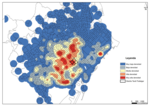Citation:
| the_economic_transformations_of_inner_urban_areas._the_barcelonas_trafalgar_garment_district.pdf | 2.31 MB |

Abstract:
The globalization of the economy has direct consequences in the transformation of inner urban spaces. The competition between higher and lower value-added activities for locating in central urban spaces causes the displacement or the disappearance of the latter. Thus, inner urban spaces are accommodating new economic activities related to culture, creativity, knowledge, with massive use of ICTs, and tourism, to the detriment of traditional activities. The Trafalgar Garment District (TGD), located in downtown Barcelona, is an economic urban space historically devoted to the garment wholesaling trade. External and internal shocks to the textile industry in the last 50 years caused, firstly, the disintegration of the Catalonian garment regional cluster which supplied textile goods to wholesale firms in TGD. Secondly, they also caused either the disappearance or the relocation of wholesale firms to the metropolitan area. As a result, the TGD`s empty spaces have become occupied with firms related to the lodging industry and to the new economy. In the case of the lodging industry, TGD has become a hot spot reflecting in the building of new hotels. Regarding new economy firms, they are microbusinesses concentrating in co-workings and fab labs. The consequence of the increase of higher value-added firms in the TGD is the bloom of businesses which satisfied higher-skilled worker`s demands as fancy restaurants, art galleries and other cultural amenities. In spite of this fact, some wholesale firms still remain. They are adopting new management strategies, upgrading their products and restructuring their internal organization to become more competitive.
DOI: 10.13140/RG.2.2.15738.29128

